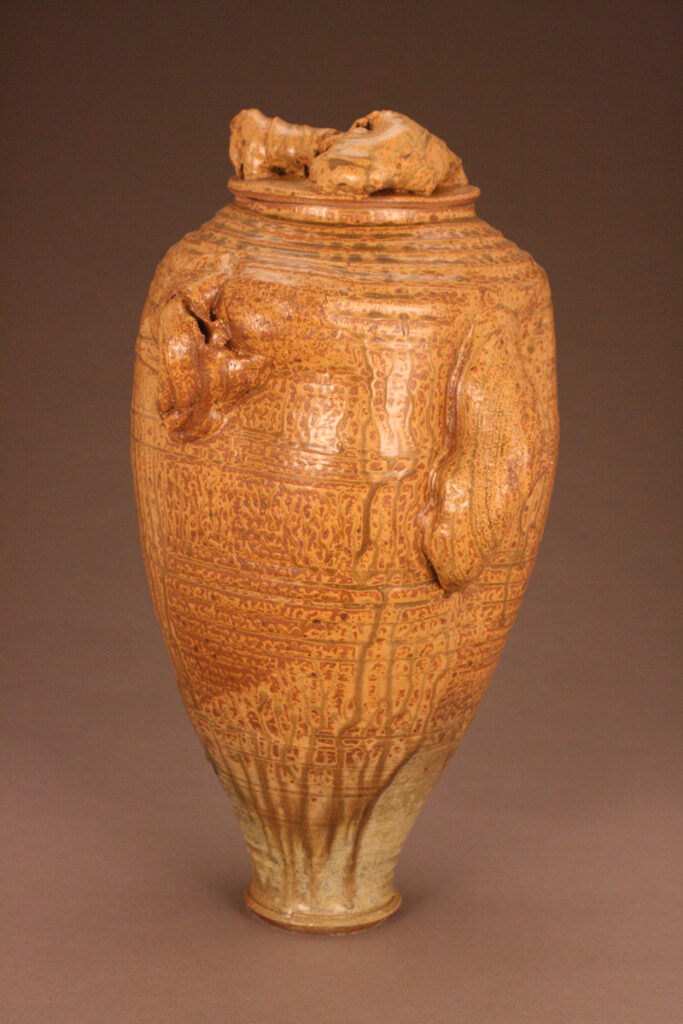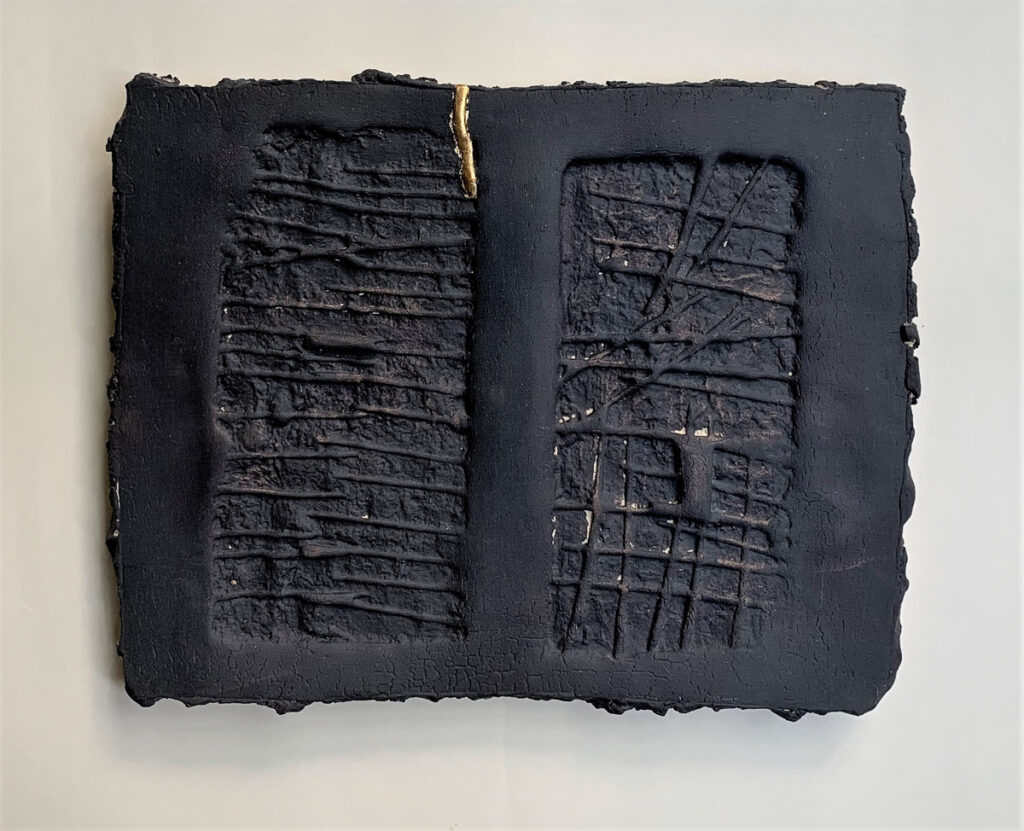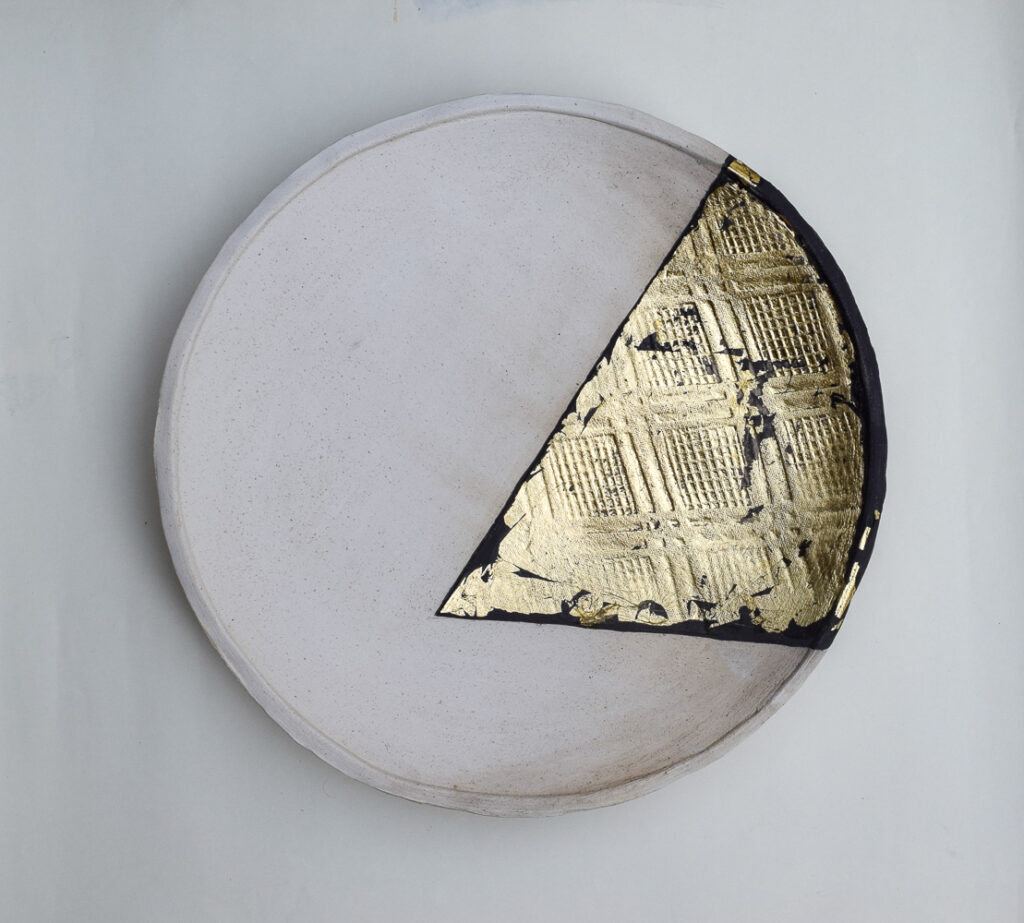- Rahul Kumar; memory keeper 2, 2017, stoneware clay, stain; 12x12x4 in
- Rahul Kumar; Harmonic Discord ; 2009; Stoneware clay; 26x16x16 in
- Rahul Kumar; original shadow 5; 2019; stoneware clay, gold-leaf; 10x11x1 in
- Rahul Kumar; Rotation 2; 2018; stoneware clay, stain, gold-leaf; 15x15x5 in
Utkarsh interviews Indian ceramic artist Rahul Kumar about his art and science of technique.
In a practice that spans 25 years, ceramic artist Rahul Kumar uses the medium of clay to explore the politics of form and constructs narratives through a textured play between space and scale. Each body of work thus becomes a story in itself, that re-imagines the material beyond its functional constraints while emboldening its sculptural capacity. Arriving from a chance encounter with clay in childhood, Kumar would build a cohesive understanding of his practice and continue to earn a Fulbright Scholarship to complete his Master’s in Art from the University of Dallas (USA); subsequently receiving the prestigious Charles Wallace award to study in the UK. He is a three-time recipient of the AIFACS National Award and the Junior Fellowship of Excellence by the Government of India. Kumar has had nine shows to his name, in India and abroad, with his works being part of eminent collections world over, including the Kiran Nadar Museum of Art in India.
In the excerpted conversation below, Rahul Kumar, speaks about his evolution as a ceramic artist and his relationship with the medium of clay.
✿ Describe your initial encounters with the medium of ceramics?
Many of us grow up playing with mud and clay as children and it was not any different for me. However, watching a traditional potter left a deep impact on me, just about 25 years back! It was magic. I was fascinated to see a lump of clay being pushed to the centre of a rotating wheel and then be moulded into a hollow form, almost effortlessly.
✿ Take us through your artistic process and the larger thematic concerns in your practice. How aware are you of the final form that your works take?
My practice is not conceptual in nature, and therefore, materiality, process, and aesthetics become more important for me. There are references and visual inspirations for each body-of-work. For instance, currently I am interested in architectural forms and city views. Patches and grids, bold forms that are heavily textured form the core of my language. I most often work in a planned manner. But the sheer process of clay is so unpredictable that I cannot ever claim complete control of what turns out eventually. A lot is left to chance.
✿ From being trained as a studio potter, to using the medium to explore sculptural forms and a narrative approach. What facilitated this transition?
While making forms with a function was fascinating, it was also creatively limiting. When I received the Fulbright Scholarship to study arts in the US, I was not even aware of the opportunities the experience will throw open for me. The study of western contemporary arts during my masters provided the foundation for me to use my medium to truly express with it. It equipped me to take the journey into the world of art.
✿ Tell us more about Rahul Clay Studio and its journey. What role does teaching play in broadening your understanding as an artist?
It is not really a formal setup. It remains a private space where I work. I do not have any assistants. I do take classes and that is very enriching. Only those with a serious commitment to clay are inducted to my classes and the onus to prove the commitment is not on me! Teaching is enjoyable and, in the process, I feel I gain immensely. Ceramic practice rides on a sound foundation of science. Theory of the process and technique to develop skills are probably more significant for clay than many other media. Of course, art itself is as wide as the ocean. Debates and discussions with my students are energizing.
✿ Do you consider your practice to be a part of the larger tradition of contemporary art? What are some of your concerns regarding the future of ceramic arts in India?
“Tradition of contemporary” feels an oxymoron! That aside, my practice is certainly contemporary in nature, although my works rarely react to any deep socio-political environment of our times. There may be aesthetic references to, say, the urban. Ceramics in the contemporary art scene in India is still at a nascent stage as compared to the west. A lot has moved in a positive direction in the past two decades. Galleries are accepting of the medium, art fairs showcase ceramic works, and we had a very successful first edition of the Indian Ceramic Triennale. Personally, I feel the big gap exists with clay-practitioners’ understanding and aspiration to get on to the track of being artists, or even appreciating that these (art vs utilitarian pottery) are altogether different disciplines.
✿ What role do collaborations play in your practice?
personally feel collaborations are very enriching. We have a tendency to keep heads down as practitioners. Through deep partnerships, I feel the exchange of ideas and influences can be valuable. I have had one-time collaborations in the past. For instance, it was phenomenal to work with RAQS Media Collective. They are so deeply entrenched in concepts and that was a contrast to my own process. While each of my collaborative projects has concluded with great results, there are times when there is a complete mismatch in basic ethics and values. There is nothing much one can do when commitment levels are poor and approach is merely entitlement based. Such partnerships do not carry on, but they too have left me more aware and sensitive.
✿ What is the kind of relationship you share with curators and galleries, in contextualizing your works into exhibitions?
For a long time, I participated through invitation at shows hosted by galleries. To separate your own self from the process of generating an audience is liberating. I am now represented by Gallery Exhibit320 in New Delhi. I see my gallery as a partner, a support system, and most importantly a sounding board. I trust their guidance and ability to present and contextualize my work. Similarly, I have had the opportunity to work with very able curators. Deep interaction with them to develop an idea itself is enjoyable and hugely helpful. I feel it is important to be prepared and accept to be ‘pushed’ out of one’s comfort zone to truly benefit from a curatorial intervention.
✿ How does the audience inform your practice? Could you recount some interactions with the audience that have stayed with you?
Most of my works are non-representational and while I provide information to support my narration, a lot is left to be interpreted. So, in a way, the work is completed only after it has been viewed! That being said, I do not consciously let the opinion of the audience impact my thought process. The practice of art is a personal journey. One of my collectors disapproved of my work in the first show after my masters (I believe it was my first step away from classical forms). Though I understood his point of view and desire, I made no change in my direction really.
✿The ongoing pandemic has encouraged new ways of thinking and working within the arts. What are some of the broad takeaways from this time? What have you been currently working on?
This time has given many of us an opportunity to slow down a bit and make the journey inwards. I have been preparing for two curated exhibitions that were planned for later this year. They are bound to get pushed out, but I am enjoying working in my studio, which has always been a quiet private space for me.

Rahul Kumar (Photo by Dilip Chobisa)
Author
Utkarsh is a writer and photographer based in New Delhi, he graduated from Srishti School of Art, Design and Technology, Bengaluru, and attended the Professional Photography Program at Pathshala South Asian Media Institute, Dhaka. Utkarsh is interested in the history of photography in South-East Asia and documentary practices in lens-based media.





